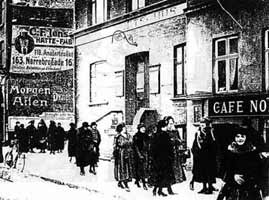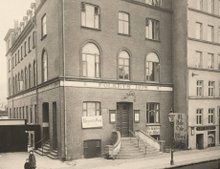Clara Zetkin (1857 - 1933)
 Clara Zetkin (1857-1933) |
Early life as Socialist
Having studied to become a teacher, Zetkin developed connections with the women's movement and the labour movement in Germany from 1874. In 1878 she joined the Socialist Workers' party (Sozialistische Arbeiterpartei, SAP). This party had been founded in 1875 by merging two previous parties: the ADAV formed by Ferdinand Lassalle and the SDAP of August Bebel and Wilhelm Liebknecht. In 1890 its name was changed to its modern version Social Democratic Party of Germany (SPD).Because of the ban on socialist activity in Germany placed by Bismarck in 1878, Zetkin left for Zurich in 1882 then went into exile in Paris. During her time in Paris she played an important role in the foundation of the Socialist International socialist group. She also adopted the name of her partner, the Russian revolutionary Ossip Zetkin, with whom she had two sons. Later, Zetkin was married to the artist Georg Friedrich Zundel from 1899 - 1928.
In the SPD, Zetkin, along with Rosa Luxemburg, her close friend and confidante, was one of the main figures of the far-left revolutionary wing of the party. In the debate on Revisionism at the turn of the twentieth century she attacked the reformerist theses of Eduard Bernstein along with Luxemburg.
Fighter for Women's Rights
Zetkin was very interested in women's politics, including the fight for equal opportunities and women's suffrage. She developed the social-democratic women's movement in Germany; from 1891 to 1917 she edited the SPD women's newspaper "Die Gleichheit" (Equality). In 1907 she became the leader of the newly-founded "Women's Office" at the SPD. She started up the first "International Women's Day" on 8 March 1911.During the first world war, Zetkin, along with Karl Liebknecht, Rosa Luxemburg and other influential SPD politicians, rejected the party's policy of Burgfrieden (a truce with the government, promising to refrain from any strikes during the war). Among other anti-war activities, Zetkin organised an international socialist women's anti-war conference in Berlin in 1915. Because of her anti-war opinions, she was arrested several times during the war.
Radicalisation towards Communism
In 1916 Zetkin was one of the co-founders of the Spartacist League and the Independent Social Democratic Party of Germany (USPD) which had split off in 1917 from its mother party, the SPD, in protest at its pro-war attitude. In January 1919, after the German Revolution in November of the previous year, the KPD (Communist Party of Germany) was founded; Zetkin also joined this and represented the party from 1920 to 1933 in the ReichstagUntil 1924 Zetkin was a member of the KPD's central office. From 1927 to 1929 she was a member of the party's central committee. She was also a member of the executive committe of the Communist International (Comintern) from 1921 to 1933. In 1925 she was elected president of the German left-wing solidarity organisation Rote Hilfe (Red Aid). In August 1932, as the chairperson of the Reichstag by seniority, she called for people to fight National Socialism.
When Adolf Hitler and his National Socialist German Workers Party took over power, the Communist Party of Germany was banned from the Reichstag following the Reichstag fire in 1933. Zetkin went into exile for the last time, this time to the Soviet Union. She died there on 20 June 1933 aged nearly 76. She was buried by the wall of the Kremlin in Moscow.
source:
www.germannotes.com







